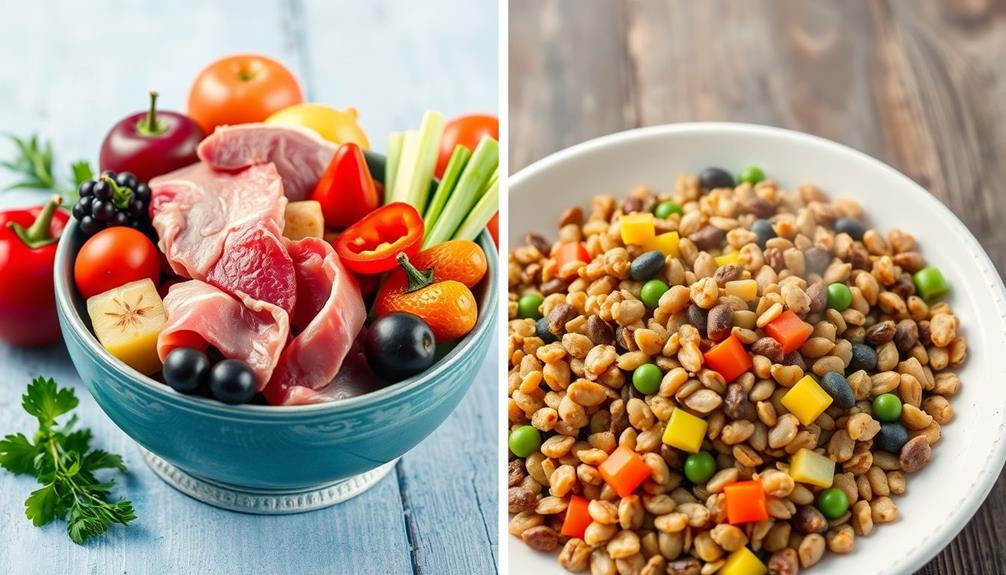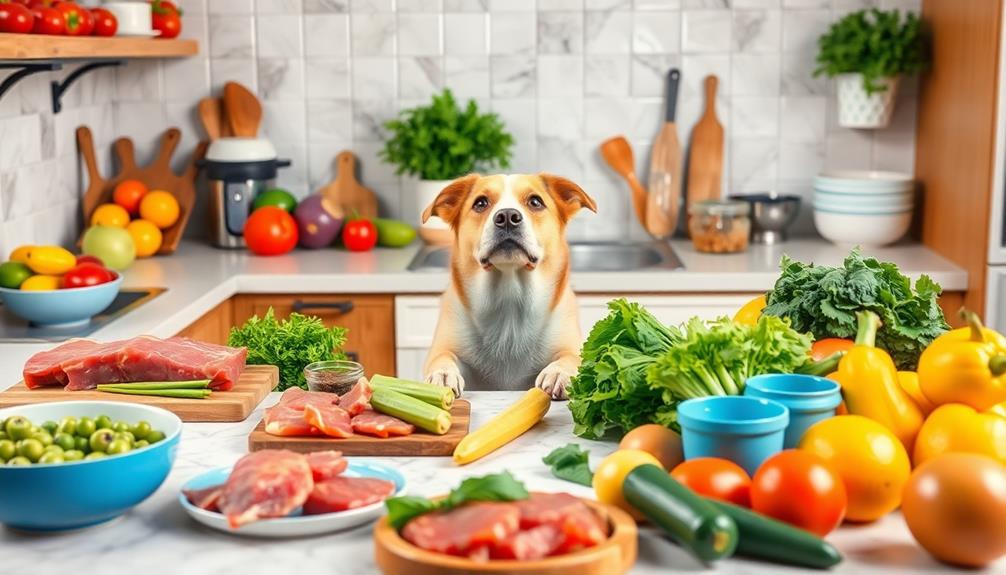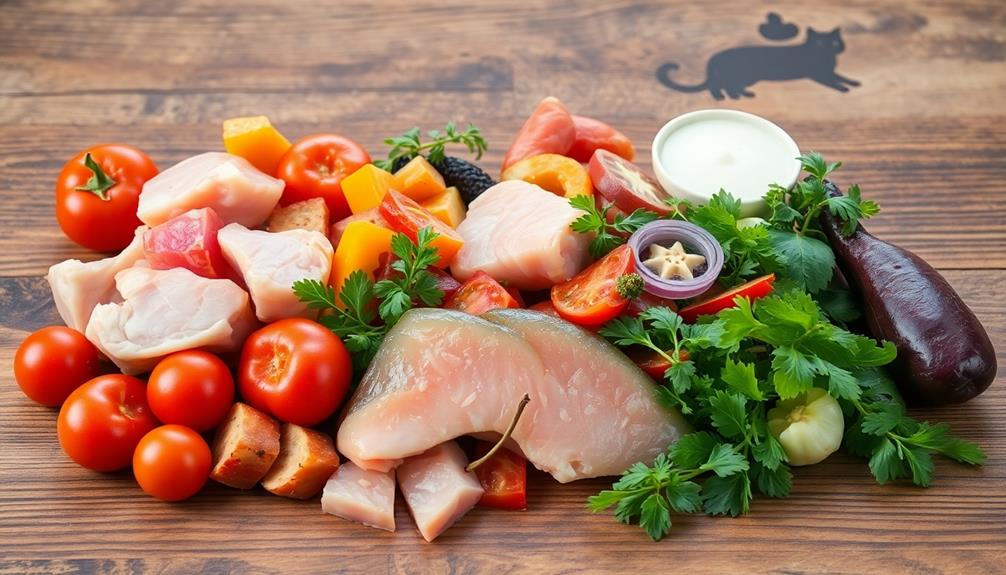You won't believe the amazing transformations pets experience on a raw food diet! Many pet owners have reported significant boosts in energy, improved coat conditions, and a reduction in health issues like allergies and digestive problems. For example, Ferguson became more playful and had a softer coat within just six months. Harley saw relief from severe food allergies, while Skeeter improved his weight management despite chronic health challenges. These stories highlight the raw diet's impactful benefits. Want to discover how you can achieve similar success for your furry friend? There are plenty of inspiring examples waiting for you!
Key Takeaways
- Many pets, like Ferguson and Harley, experienced significant health improvements, including increased energy and alleviated allergies, after switching to a raw food diet.
- Skeeter gained weight and normalized health markers despite chronic conditions, showcasing the potential of raw diets for special health needs.
- Pets like Baloo and Remington showed enhanced vitality and reduced skin issues, demonstrating the transformative effects of raw feeding on overall well-being.
- Owners reported improved coat conditions and digestion, with notable reductions in stool odor after transitioning their pets to raw diets.
- Community testimonials highlight the positive behavioral changes and strengthened bonds during mealtime due to the enticing nature of raw food options.
Ferguson's Transformation Journey

Ferguson's transformation journey highlights the remarkable impact of tailored nutrition on a pet's health and well-being. As a senior Persian cat, Ferguson faced considerable health issues before switching to a raw food diet.
After shifting from a veterinary-prescribed diet, you'd see him become more playful and his coat would soften within just six months. The raw diet, which included crushed eggshells to keep phosphorus levels low, effectively addressed his diarrhea and urinary tract infections.
You'd notice that Ferguson no longer had gastrointestinal problems; his digestion smoothed out, and hairball issues considerably reduced, thanks to the Gut Soothe Probiotic. This change not only enhanced his physical health but also improved his grooming behavior, making it easier for you to maintain his coat and reducing matting.
Ferguson's success story serves as a beacon for pet owners considering raw diets for their senior pets. It emphasizes the health benefits of tailored nutrition, demonstrating that the right diet can dramatically improve your pet's quality of life.
If you're contemplating a similar change, Ferguson's journey could inspire you to explore the potential of a raw food diet for your beloved companion.
Nutritional Struggles and Solutions

When pets struggle with health issues like diarrhea and urinary tract infections, it often stems from poor-quality diets that lack crucial nutrients. You might find that these stomach issues not only affect their comfort but also their overall pet health.
Shifting to raw food diets can be a game changer. These diets consist of uncooked, unprocessed ingredients that address various health concerns.
Many pet owners, like those with Ferguson, have reported significant improvements in their pets after making this switch. Raw food diets often lead to increased energy levels, better digestion, and enhanced coat condition.
For senior pets, nutritional adjustments like lower phosphorus levels and high moisture content can lead to better kidney function and reduced gastrointestinal problems.
The success stories speak volumes. By tailoring your pet's diet to their specific needs, you can alleviate allergies and boost vitality.
It's crucial to guarantee your pet receives the right balance of nutrients, as this can dramatically improve their quality of life. If you're facing any nutritional struggles, consider raw food diets as a viable solution for your furry friend's health issues.
Advantages of Raw Diet

Many pet owners are discovering the numerous advantages of switching to a raw food diet for their furry companions. One significant benefit is improved digestion. You might notice reduced stool odor and easier weight management, thanks to the high moisture content in raw foods.
Many pet owners report their pets enjoying enhanced energy levels and a healthier coat after making the change. The nutritional balance in a raw diet closely mimics what your pet's ancestors would have eaten, providing essential vitamins and enzymes that commercial pet foods often lack.
This can lead to fewer allergies and skin issues, with many testimonials highlighting remarkable improvements in itching and hair loss after altering to raw food. Additionally, you'll find that raw feeding can be a more cost-effective option.
Financial analysis shows it can be nearly half the price of canned food, allowing you to provide high-quality nutrition without breaking the bank. By opting for a raw diet, you're not just improving your pet's health; you're enhancing their overall quality of life, making it a decision worth considering for both you and your furry friend.
Notable Health Improvements

You might be amazed at the notable health improvements pets experience after switching to a raw food diet.
Many owners report enhanced energy levels, improved coat condition, and a reduction in various health issues.
These transformations not only boost your pet's liveliness but also enhance their overall well-being.
Enhanced Energy Levels
Pets often experience a remarkable boost in energy levels after switching to a raw food diet. Many pet owners notice their furry friends become more playful and active within just weeks of altering their feeding habits to raw.
For example, Harley, who struggled with severe food allergies, showed significant energy after adopting a raw diet, transforming his overall pets health.
Similarly, Tobi, an 18-month-old Great Dane, exhibited enhanced alertness and enthusiasm to play once raw food became a staple in his meals.
Even senior pets can benefit; a husky regained mobility and energy through dietary changes, highlighting that raw feeding can rejuvenate older animals.
Products like Vital Essentials are recognized for promoting higher energy and vigor, with numerous pet families reporting increased excitement for activities in their pets.
Whether it's chasing a ball or enjoying a leisurely walk, the change to a raw food diet often leads to noticeable improvements in energy levels.
If you're considering this dietary change for your pet, you might just witness a transformation in their activity and overall zest for life.
Improved Coat Condition
A stunning transformation in coat condition often accompanies the change to a raw food diet. Many pet owners report that their furry friends, once plagued by dullness, now sport shinier coats after altering to a raw pet diet rich in high-quality fats and proteins.
Take Harley, for example. After he switched to Freeze-Dried Raw Chicken Mini Nibs due to severe food allergies, his coat improved dramatically, becoming lustrous and vibrant while reducing skin irritation.
Barney's experience further highlights the benefits of a natural diet; after incorporating raw salmon skins, he noticed his coat became less odorous and more vibrant. The high moisture content in raw diets plays an essential role, supporting skin hydration and enhancing coat texture and shine—especially beneficial for pups with sensitive skin.
Even older pets, like Abber, a 16+ year old Jack Russell, showed remarkable revitalization. After adding freeze-dried turkey toppers to his meals, his coat health greatly improved.
These success stories illustrate how a raw food diet can lead to noticeable improvements in coat condition, making your pet look and feel their best.
Reduced Health Issues
While many pet owners hope for a healthier companion, altering to a raw food diet often yields remarkable health improvements that exceed expectations.
Pets like Harley have experienced significant relief from severe food allergies and skin issues after switching to Freeze-Dried Raw Chicken Mini Nibs. Their owners reported enhancements in skin condition, coat quality, and energy levels.
Skeeter, diagnosed with chronic heart disease, surprised veterinarians by gaining weight and normalizing hypothyroidism levels after adapting to a raw diet.
These stories highlight the potential of quality pet food to address serious health issues.
Even dogs with sensitive stomachs, like Baloo, have shown increased enthusiasm and alertness after incorporating raw options such as Essential Freeze-Dried Rabbit into their meals.
With numerous success stories emerging, it's clear that a raw diet can lead to crucial transformations in your pet's health.
Real-Life Success Stories

Real-life success stories demonstrate the transformative power of a raw food diet for pets.
Take Harley, for instance. After switching to Freeze-Dried Raw Chicken Mini Nibs from Essential Elements, his severe food allergies and skin issues improved dramatically. You'd be amazed at how his coat shine and energy levels surged.
Then there's Skeeter, who battled chronic heart disease. By adopting clean, whole animal food, he not only regained weight but also normalized his hypothyroidism levels, stunning his vet.
Baloo, a notoriously picky eater, found new joy in mealtime after mixing Essential Elements Freeze-Dried Rabbit with his kibble for just three months. His increased alertness was a delightful surprise.
Remington's itching drastically reduced after making a shift to a raw diet, showcasing how effective high-quality, single-ingredient options can be for dogs with dietary restrictions.
Lastly, consider Abber, a 16+ year old Jack Russell. Incorporating freeze-dried turkey toppers into his diet revitalized his health, proving that raw feeding can greatly benefit senior pets.
These stories highlight how a raw diet can truly transform your pet's well-being.
Special Cases: Unique Challenges

When you switch your pet to a raw food diet, you might face unique challenges that require some adjustments.
You'll need to address their specific health needs, preferences, and keep an eye on their progress over time.
Understanding these factors can help you create the best nutrition plan for your furry friend.
Nutritional Adjustments for Health
Managing the nutritional needs of pets with unique health challenges can be intimidating, but making the right adjustments can lead to remarkable improvements. Shifting to a raw food diet often proves beneficial, as many pet owners find that certain brands like Blue Buffalo offer high-quality protein sources that cater to sensitive stomachs.
For instance, pets like Harley experienced considerable relief from severe food allergies and skin issues after switching to Freeze-Dried Raw Chicken Mini Nibs.
If your pet suffers from pancreatitis, dietary management is essential. A carefully supervised raw food diet can help reduce flare-ups and enhance overall health.
Dogs with sensitive stomachs, such as Tato, thrive on easily digestible raw food options, improving their meal enthusiasm while addressing digestive concerns.
Case studies reveal the importance of tailored nutrition. Skeeter's switch to clean, whole animal food not only normalized health issues like hypothyroidism but also led to healthy weight gain.
Similarly, Abber, a 16+ year-old Jack Russell, was revitalized by freeze-dried turkey toppers, showcasing how quality nutrition can greatly enhance vitality in senior pets.
Overcoming Dietary Preferences
Overcoming dietary preferences in pets can be a challenging yet rewarding journey. As a pet parent, you might face unique challenges, especially if your furry friend is a picky eater.
Shifting from highly processed kibble to raw food can greatly enhance their eating enthusiasm and overall well-being. Research shows that improving a pet's diet can lead to better health outcomes, similar to the benefits seen in the role of pet therapy for emotional well-being in animals.
Here are three strategies to help you navigate this process:
- Gradual Introduction: Start by mixing small amounts of raw food with their current diet. For instance, you can combine Essential Freeze-Dried Rabbit with kibble. Slowly increase the raw food ratio over time.
- Variety is Key: Dogs, like Kalea, often respond positively to different textures and flavors. Explore various raw options, such as Essential Frozen Patties, to find what your pet enjoys the most.
- Monitor Reactions: Keep an eye on your pet's health and behavior. Positive changes in coat health and digestion, as seen with Nash, can be indicators that you're on the right track.
Monitoring Long-term Progress
Monitoring the long-term progress of your pet on a raw food diet is crucial for guaranteeing they continue to thrive. Regular check-ups with your veterinarian will help you adjust dietary plans based on any changes in health, especially for aging pets like Toby the Mini Schnauzer, who may experience gastrointestinal discomfort.
Observing health improvements, such as increased playfulness and better coat condition, can reinforce your decision to stick with a raw diet. It's also important to verify that any new foods introduced, like fruits, are safe for dogs, as some can be toxic, such as grapes.
Take Harley's success story, where tracking skin health and energy levels notably highlighted the benefits of the raw diet. You'll want to document any shifts in your pet's behavior or well-being, just like Baloo's owner did, to identify preferences and nutritional needs over time.
This tailored approach guarantees your pet receives the best care possible. Additionally, keep an eye on unique challenges that may arise, such as a senior husky regaining mobility.
Cost Analysis of Raw Feeding

When pondering a raw food diet for your pet, it's essential to evaluate the costs involved. The monthly expenses for raw feeding can reach around $350 for a single dog. This includes various components such as organs ($50), raw meaty bones ($85), and muscle meat ($150).
While the initial cost might seem intimidating, it's worth noting that many owners find long-term savings through improved health, potentially leading to fewer veterinary visits.
To help you with your cost analysis, here are three key points to reflect on:
- Economical Choice: Raw feeding can be nearly half the price of canned food when you calculate over time, making it an attractive option for budget-conscious pet owners.
- Affordability Options: There are various ways to tailor your budget while still offering high-quality nutrition, ensuring your pet lives their best life.
- Health Benefits: The financial investment in raw feeding is often justified by reported health improvements, which can reduce medical issues and enhance your pet's well-being, as supported by the Humane Society.
Ultimately, a raw food diet could be a worthwhile investment in your pet's future.
Transitioning to Raw Diet

Shifting your pet to a raw diet can lead to remarkable health benefits, including higher energy levels and improved digestion. To guarantee a smooth changeover, it's best to take your time. Gradually introduce the raw diet over 7 to 10 days, starting with a mix of their current food and raw options. This method helps minimize any digestive upset.
Experimenting with various high-quality protein sources—like chicken, beef, and fish—can also aid in finding what your pet prefers and tolerates best. Some pets may be picky eaters, so incorporating high-quality raw options, such as freeze-dried or dehydrated products, might make the changeover more appealing.
Throughout this process, maintaining nutritional adequacy is essential. It's wise to consult with your veterinarian to guarantee your pet receives a balanced diet during the changeover.
Impact on Pet Well-Being

The impact of a raw food diet on your pet's well-being can be truly life-changing. Many pet owners report remarkable health improvements after making a change for their furry friends to raw options. You might notice benefits like increased energy, a shinier coat, and even resolution of food-related issues.
Here are three key improvements you may observe:
- Enhanced Skin and Coat Health: Pets like Harley have shown significant reductions in skin issues and allergies after switching to raw diets, leading to a healthier, more vibrant coat.
- Improved Digestion and Appetite: Picky eaters, such as Baloo, often thrive on raw food, showing enthusiasm at mealtime and better digestion when raw options are mixed with kibble.
- Increased Energy: Older pets, like Abber the Jack Russell, exhibit revitalized health and energy levels, showcasing the positive effects of incorporating freeze-dried food into their diet.
Frequently Asked Questions
How Long Does It Take to See Results From a Raw Diet for Dogs?
You'll typically see noticeable results from a raw diet for your dog within 2 to 4 weeks, with improvements in energy, digestion, and coat condition. Some changes, like skin issues, might take longer to resolve.
Will My Dog Lose Weight on a Raw Diet?
Imagine your dog running like a gazelle, shedding pounds effortlessly. Yes, your dog can lose weight on a raw diet. With higher protein, lower carbs, and better digestion, you'll see those pounds melt away.
Are Dogs Happier on Raw Diet?
Yes, dogs can be happier on a raw diet. You'll likely notice increased energy, improved mood, and greater enthusiasm during mealtimes. Enhanced digestion and healthier skin contribute to their overall well-being and contentment.
How Successful Is the Raw Food Diet?
The raw food diet's like a refreshing change for pets, rejuvenating their health. You'll notice improved energy, digestion, and coat quality. Many owners celebrate their pets' transformations, proving its success is undeniable and promising.
Conclusion
As you consider the raw food diet for your pet, imagine the vibrant transformation waiting just around the corner. Picture your furry friend, full of energy and liveliness, thriving in ways you never thought possible. But what if you could access even more health benefits? The success stories shared here are just the beginning. Are you ready to take the leap and discover the incredible impact a raw diet could have on your pet's well-being? The journey awaits!










